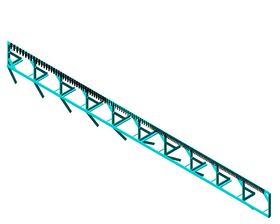Difference between revisions of "Broadband Tagger Hodoscope"
| Line 1: | Line 1: | ||
[[Image:tagger_fixed_array-Model3.jpg|280px|]] | [[Image:tagger_fixed_array-Model3.jpg|280px|]] | ||
| − | The coarse fixed-array hodoscope consists of | + | (Note: the figure will be updated shortly (10/08)). |
| − | The scintillator array detects scattered electrons in the energy range of 0. | + | |
| + | The coarse fixed-array hodoscope consists of 190 scintillators distributed over a length of 10 m on the focal plane of the two-magnet system. | ||
| + | The high-resolution device ([[Tagger_Microscope]]) will be positioned behind the fixed array. | ||
| + | The scintillator array detects scattered electrons in the energy range of 0.3 to 9 GeV (for a 12 GeV electron beam), i.e. it will tag photons between 3.0 GeV and 11.7 GeV. | ||
The device will primarily be used to | The device will primarily be used to | ||
* measure the energy spectrum during the calibration of the radiator crystals, | * measure the energy spectrum during the calibration of the radiator crystals, | ||
* monitor the photon energy spectrum during data taking with coherent bremsstrahlung photons, and | * monitor the photon energy spectrum during data taking with coherent bremsstrahlung photons, and | ||
| − | * the | + | * the energy range of electrons between 0.3 to 3 GeV will be additionally used during data taking to detect any electrons whose associated bremsstrahlung photons have energies above 9.0 GeV in order to account for possible beam photon candidates with higher energies than covered by the variable microscope. |
In order to allow for operating the hodoscope at the projected high rates, only the high-photon-energy range (<i>E<sub>γ</sub></i>>9.0 GeV) will be fully covered with detectors; the remaining range will be sampled by 50%. | In order to allow for operating the hodoscope at the projected high rates, only the high-photon-energy range (<i>E<sub>γ</sub></i>>9.0 GeV) will be fully covered with detectors; the remaining range will be sampled by 50%. | ||
All counters will be mounted at angles such that they face normal to the path of the scattered electrons. | All counters will be mounted at angles such that they face normal to the path of the scattered electrons. | ||
| − | The construction of the hodoscope allows for later addition of counters to fully cover the whole energy range by filling the gaps between the 50% sampling scintillators and | + | The construction of the hodoscope allows for later addition of counters to fully cover the whole energy range by filling the gaps between the 50% sampling scintillators and filling the second row of PMTs. |
| + | In order to enable the positioning of the scintillators close to the thin focal-plane window of the vacuum chamber, the PMTs are positioned below the flange of the vacuum window at a distance 30cm below the scattering plane. A second row of PMTs is necessary to allow the full tagging coverage above <i>E<sub>γ</sub></i>>9.0 GeV. | ||
| + | Straight lightguides connect the tagger scintillators to the PMTs. | ||
| + | |||
See [[Specification for broad-band tagging hodoscope]] for details. | See [[Specification for broad-band tagging hodoscope]] for details. | ||
Revision as of 10:16, 16 October 2008
(Note: the figure will be updated shortly (10/08)).
The coarse fixed-array hodoscope consists of 190 scintillators distributed over a length of 10 m on the focal plane of the two-magnet system. The high-resolution device (Tagger_Microscope) will be positioned behind the fixed array. The scintillator array detects scattered electrons in the energy range of 0.3 to 9 GeV (for a 12 GeV electron beam), i.e. it will tag photons between 3.0 GeV and 11.7 GeV.
The device will primarily be used to
- measure the energy spectrum during the calibration of the radiator crystals,
- monitor the photon energy spectrum during data taking with coherent bremsstrahlung photons, and
- the energy range of electrons between 0.3 to 3 GeV will be additionally used during data taking to detect any electrons whose associated bremsstrahlung photons have energies above 9.0 GeV in order to account for possible beam photon candidates with higher energies than covered by the variable microscope.
In order to allow for operating the hodoscope at the projected high rates, only the high-photon-energy range (Eγ>9.0 GeV) will be fully covered with detectors; the remaining range will be sampled by 50%.
All counters will be mounted at angles such that they face normal to the path of the scattered electrons. The construction of the hodoscope allows for later addition of counters to fully cover the whole energy range by filling the gaps between the 50% sampling scintillators and filling the second row of PMTs. In order to enable the positioning of the scintillators close to the thin focal-plane window of the vacuum chamber, the PMTs are positioned below the flange of the vacuum window at a distance 30cm below the scattering plane. A second row of PMTs is necessary to allow the full tagging coverage above Eγ>9.0 GeV. Straight lightguides connect the tagger scintillators to the PMTs.
See Specification for broad-band tagging hodoscope for details.
